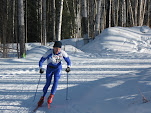Can't help but discuss the weather a bit. We've been locked into a nearly unprecedented cold snap for four weeks now and we're just starting to crawl out of it. Old timers and weather records say it hasn't been this cold, this long, this late since the early 1960s. Stationary low pressure systems in NW Canada and Bering Sea have resulted in a perpetual swirl of cold air streaming over most of Alaska.
After a reasonable, almost mild early February (with highs in the mid-teens, lows something below zero), the system moved in and we were locked into -40s at night, and highs barely reaching -20. That is late for this area, which is usually one of the best times of the year if you like doing things outdoors. Rather than embracing the last month of winter--which everybody looks forward to--it got harder and harder to just get out the door and put in a workout. Finally, however, on Friday after 26 days of sub zero, the thermometer climbed to about 10 degrees.
Saturday dawned brilliant and clear, and at race time the thermometer at UAF read +6, quite nice difference from the -32 at the snowshoe race three weeks ago. I joked to anyone in sight that springtime in Alaska sure is nice! They laughed politely but probably wanted to kill me.
Our race was the 20k Skiathon, a classic race and a long-standing campus tradition dating back to the 1970s. The Skiathon used to be a much bigger event, now it's pretty small, averaging about 60 to 100 skiers a year. I really like this one because a) it's the only race not at Birch Hill and b) because of that it has a much more laid back feel. Nevertheless, the competition is pretty good.
The skis were running well in the warmup--with solid kick and glide--and I felt confident for a decent race. As usual the first few ks are furious with a lot of double-poling and jockying for postion. A lead pack of a couple college skiers and Fairbank's best citizen racer pulled ahead, and I settled into a 2nd pack of four. In the open areas the snow was so grainy and windblown that we had to step out of the track while doing an arduous double pole. At 5k on Smith Lake I suddenly found myself leading our pack--not quite where I wanted to be, but I pushed through the wind with the others in tow. Probably not a great tactical move, but it did break up the pack, and by the climb into the Potato Fields there were only two of us. I let up and let Matt, a new grad student here, pull for a while. However, I'd already fallen into oxygen debt, and strugged to maintain contact. By 8k he was pulling away, with Will and Max about 100 m back.
Normally, I should be strongest on the hilly loops between 7 and 10k, but was just hanging on. Max reeled me in and by 10k and we skied side-by side, taking in some feed at the only aid station. But with the climbing over with, I took in some oxygen, and on a short steep uphill was able to pull away again. From then on the course is mostly double polling. The downhills aren't quite steep enough to glide, so you just hammer with rapid fire double poling. At about 18k, I could see Matt ahead about 40-50 sec, and thought maybe he was slowing down. I pushed till 19 or 19.5 k and then eased it in for 5th.
All in all a good day. Sometimes, when you get a rough stretch of weather here, you wonder if it's worthwhile. But, if you mix in the good (dog races, Tour of Anchorage, and events like the Skiathon) witht the bitter cold--yes, it's worthwhile. Note to self for next year: take it easy on the lake and wait for the hills!
1. Spangler (UAF) - 1:07:51
2. Viavant (Montana State) - 1:08:29
3. Kramer (local citizen racer) - 1:10:03
4. Matt (grad student)- 1:13:49
5. Me (geezer) - 1:15:07
6. Will (UAF) - 1:15:57
7. Max (local citizen racer) - 1:16:20
8. Ingrid (UAF assistant coach and local racer) - 1:19:53



